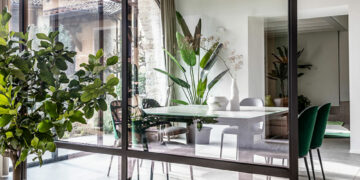A plant stand may seem to be an inconsequential object, but it can serve many purposes. Some plant stands serve as pieces of furniture or artwork in homes, giving a tasteful touch to the energy of a room. Of course, the main goal is to get the plant off the floor and onto an elevated surface of its own.
De plus, Why you need a plant stand?
Saving space and money
A plant stand is higher than an ordinary flowerpot. Placing plants in a plant stand leaves space on the floor and between the stands. This way you can place twice as many plants in one place! It is also true that a plant stand often has room for more than one plant.
d’ailleurs What size plant stand should I get? To find the right size planter, consider the height and dimensions of your house plants. Different plants grow to varying height and widths, which impacts the size of the plant stand you will need. A general rule to follow is the taller the plant the lower the plant stand should be.
What is plant rack? Plant racks are great furniture pieces that will help you organize your space. Instead of leaving pots on the floor, you can use tiered racks to elevate your plants and free up some floor space.
d’autre part, How tall should a plant be on a table?
Generally, floor plants should be taller while plants that sit on a table, desk, or window should be shorter. Keep in mind that your plant will grow. For this reason, it’s a good idea to buy a plant that is a little smaller than the one you ultimately want.
How much weight can a plant stand hold?
This small basic plant stand is a great addition to any indoor or outdoor space and holds up to a 20 pound plant.
How do you make a plant stand up?
To stake using single plant stakes, push a stake into the ground beside the plant, making sure the stake is not taller than the plant itself. Tie the plant to the stake about two-thirds of the way up the stem using string, twine or hook-and-loop tape made especially for staking.
How do you style a plant stand?
How do I display my plants?
20 Fun and Interesting Ways to Display Your Houseplants
- Bookcases and Shelves.
- Kitchen Cabinets.
- Window Sill Displays.
- End Tables.
- Television Stands.
- Sideboard Plants.
- Fireplace Mantle Displays.
- Table Centerpiece. Repurpose: Display Your Plants with Items You Might Have.
How do you organize indoor plants in a living room?
How to Decorate with Houseplants
- Arrange in Odd Numbers. When you can, group plants in an odd number. …
- Choose Different Sizes. Group together plants with different widths and heights. …
- Think About Leaf Shapes. …
- Include Plants with Colorful Leaves. …
- Use Plenty of Decorative Pots. …
- Don’t Forget Houseplant Care.
How do you organize indoor plants in a small living room?
Group plants in cool planters together in one corner of a room. This works great with taller indoor plants, but you can also use varying height plant stands to prop up smaller plants. You can’t go wrong with this approach, which is why it’s probably our favorite way to decorate with indoor plants.
Why won’t my plant stand up?
Both indoor and outdoor plants can suffer from leaning caused by being top heavy or damage sustained from wind. Once a plant begins to lean, it can lead to more damage or prevent the plant from growing properly. Remedying the leaning is necessary to keep the plant growing properly and healthy.
What to use to hold up plants?
Single stake: The most common plant-staking method involves using a single stake. Garden centers sell wooden stakes, bamboo stakes, plastic stakes, and metal stakes to which you can attach plants with a plastic plant tie.
Why is my plant bending over?
The most common reasons why plants lean or go lopsided is due to uneven access to light. According to Richard Cheshire and Richard Hull, plant doctors at Patch, there are two main reasons why plants might go wonky or lopsided – because they’re leaning towards the light, or because they’re too heavy or have loose roots.
Do houseplants have to be by a window?
Remember that your plants do not need direct sunlight at all possible hours of the day as this can scorch the leaves and the roots of the plant. Most plants will be happy with a window that is either West, East or South facing. So do not look to have too many plants facing a Northerly window.
Can you have too many plants in a room?
Yes, unfortunately, you can have too many houseplants. It depends from person to person on how many they can have. Health-related, there is no danger of having too many. However, if you don’t find joy caring for them, if you don’t have enough income, space or time, it means you have too many houseplants.
Is it OK to have plants in your bedroom?
Plants can absorb harmful gases through the pores in their leaves, filtering and cleaning the air you breathe every day. Not only do bedroom plants have many health benefits, but they also add a nice touch of decor and bright energy to any indoor space.
How many plants should be in a living room?
Although it is difficult to say exactly how many plants are needed to purify indoor air, Wolverton recommends at least two good sized plants for every 100 square feet (approximately 9.3 square meters) of indoor space. The bigger the plant and leafier the plant, the better.
What is a room full of plants called?
Synonyms. (room used to grow plants): conservatory, greenhouse.
Do plants like to be grouped together?
Now, grouping of plants is not only for its looks, but it also helps plants grow better. They create their own community, plants in groups always grow better than plants that grow alone. Some foliage plants simply look much more attractive when grouped together to be displayed as a single unit.
Do houseplants like to be grouped together?
Arrange in Odd Numbers
And yes, it’s completely true for houseplants: The difference between grouping two plants together and grouping three plants together is astonishing! Some people are die-hards about organizing items in trios, but any odd number will work for houseplants.
Where should I keep my house plants indoors?
Spreading plants around the perimeter and away from the center of the room can make the space appear larger. For instance, place plants on shelves, window sills, or in corners. Hanging plants are back in style, but it’s essential to find the best spot. Don’t hang a plant where tall guests can bump their heads.






